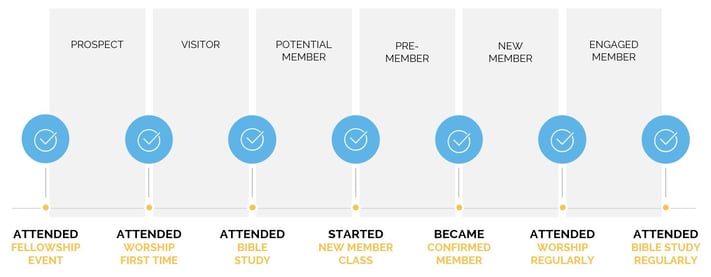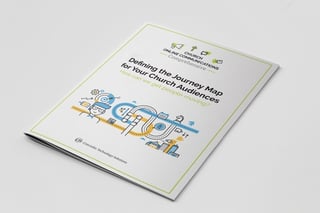
We spent the last two weeks identifying your church audiences and gaining a better understanding of who they are and how to communicate with them. Today, we're going to shift gears a bit and start planning ways to move these audiences closer to your church goals.
The way we'll do this is by creating a journey map for your audiences. This map, which could also be described as a timeline, should be based on your church goals. The starting point is right before your first point of contact with your audience, and the subsequent points, or destinations, are the desired outcomes based on your church goals.
What's the Point of a Journey Map?
A journey map provides you with another point of context to help you provide the right message to the right audience. The goal of having a journey map is to focus your communications on the next action each audience member should take to lead him or her towards your church goals.
For example, someone who is at the beginning of the journey, like a first-time visitor, does not need to receive notifications about the upcoming voters' meeting. In the same way, someone near the end of the journey, an active member, doesn’t need to be invited to the new member class that begins next month.
What's Included in a Journey Map?
Journey maps will certainly vary among congregations as they are dependent on church goals, but there are a few key elements that every journey map should have.
- Actions - The desired activities that you are encouraging your audience to take.
- Stages - Identified placements on the journey map between actions.
- Goals - Key end points on the map where you want your audience to go.

Actions
This journey map is best utilized when it focuses on trackable actions taken by individuals. It shouldn’t be used to determine the depth of someone’s faith. Rather, it should focus on outward actions that are easily identifiable to show that the person is an active member of the congregation.
To start developing a journey map, list all the possible trackable actions that individuals can take in your church. The example above contains the following ideas, but your church will likely have different actions or terms that better fit your situation.
- Attended a Fellowship Event
- Attended Worship for First Time
- Attended a Bible Study
- Started New Member Class
- Became a Member
- Attended Worship Regularly for a Year
- Attended Bible Study Regularly for a Year
Stages
Once you have established your desired actions for your audience, the next step is to name those audiences that are between stages.
Doing this provides the practical benefit of being able to consistently refer to the subset of your audience, but there is also the strategic benefit of knowing what the preferred next steps should be for the people in each stage. This will assist you in determining what communications are appropriate or not for that audience. Here are the stages displayed in the above example:
- Prospect
- Visitor
- Potential Member
- Pre-Member
- New Member
- Engaged Member
Depending on how you have established your journey map, it’s quite possible for an individual to enter the journey map at any point. As you implement the map, keep in mind that it isn't beneficial for individuals to go backwards on the journey. If there is an action that may be repeated (like attending worship or Bible study), that action should only be tracked the first time it occurs.
Goals
Your church goals should be the destinations on your map, and they should also be a subset of your actions. In other words, your goals should not be the only actions on the map, but all of your goals should be represented.
The other actions should be the logical steps that precede your goal actions. For example, if one of your church goals is to have 40% of your active membership attending Bible study, and active membership is defined as attending worship regularly, then two steps on your journey map should be "Became a Member" and "Began Attending Worship Regularly."
As you are developing your journey map, a best practice is to talk with members who have already reached your church goal and ask what steps they took to get there. As you hear their stories and start to identify trends, use that information to determine appropriate preceding actions.
Developing Multiple Journey Maps
Depending on your goals and personas, it may be appropriate to develop multiple journey maps to track proper placement of your audience. One scenario where it makes sense to have more than one journey map is when you have goals related to both a church and a school.
It may also be appropriate to split a journey map at a certain point if you have audiences that take a divergent path, such as desiring to increase livestream views among shut-in members while encouraging all other members to attend in person.

Start Creating Your Journey Map
Download the free PDF Defining the Journey Map for Your Church Audiences. This sample journey map and blank template will help you create a custom journey map that leads your audiences towards accomplishing your church goals.

Sign Up for the Course!
This blog post is the fifth in our free training series Church Online Communications Comprehensive. If you’d like to participate in the course, you can sign up today and review the material from the first four weeks. Then, tune in for our weekly Facebook Live videos or watch the recordings afterward. Each week, we’ll offer a free download that will provide tools for building your church’s communication plan.
About the Author
Follow on Linkedin More Content by Peter Frank























